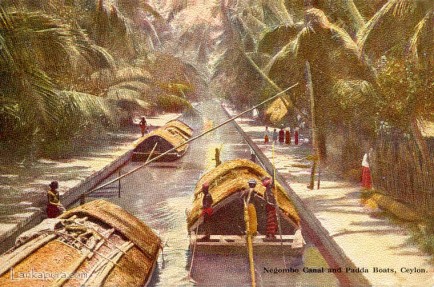
Hand-Colored photograph of Padda Boats on Hamilton Canal – (Colombo to Negombo Canal), Sri Lanka 1890
In 1802 British started a new canal to the east of the earlier cut canal by Sinhalese king and the Dutch. This canal was called Hamilton canal and meant to link the Dutch canal by a series of parallel canals designed to drain the Muturajawela. But what happened was the opposite as the high tide brought salinity not only from Negambo lagoon but also Kelani river.
During the 15th Century King Vira Parakramabahu VIII, Negombo lagoon served as the main seaport for trading in cinnamon and other commodities. It is presently called the Dutch canal and links Kelani river with the main sea port of Negambo lagoon to the east of Muturajawela.
The Hamilton Canal – how it came to be Daily News Friday May 17 2002
Garvin Hamilton, British Agent of Revenue and Commerce in 1802 started a new canal to the east of the earlier cut canal by Sinhalese king and the Dutch. This canal was called Hamilton canal and meant to link the Dutch canal by a series of parallel canals designed to drain the Muturajawela. But what happened was the opposite as the high tide brought salinity not only from Negambo lagoon but also Kelani river.
The features article under Environment on page thirty two of the Daily News of May 8, 2002 regarding the Hamilton canal carries some errors, which I wish to rectify.
During the 15th Century King Vira Parakramabahu VIII, Negombo lagoon served as the main seaport for trading in cinnamon and other commodities.
To quote the GCEC Environmental profile of Muturajawela and Negombo lagoon March 1991 (where I was a member of the Working group) it was this king, in keeping with superior economic considerations, to facilitate access and transport, who began constructing the canal.It is presently called the Dutch canal and links Kelani river with the main sea port of Negambo lagoon to the east of Muturajawela.
This led to a disaster in that the Muturajawela paddy fields were subject to saline intrusion and triggered the end of paddy cultivation in the once fertile paddy fields. (Abeysekera H.P. 1954) In the process sparking a rebellion against the King, which he could hardly suppress.During the Portuguese era that followed Negambo lagoon continued to be the main sea port for maritime trading.
The Dutch period that followed attempts were made to rehabilitate Muturajawela as a producer of paddy and develop Colombo as a sea port. The Ja ela was constructed to deliver fresh water from Attanagalu oya to flush out the salt from the soil. These attempts no doubt led to their departure as expected results never came on top of military reverses at the hands of the British. The British who followed the Dutch rule also pursued the Muturajawela bogey and undertook the rehabilitation of the swamp, as it could provide food for the subjects besides saving foreign exchange.
Garvin Hamilton, British Agent of Revenue and Commerce in 1802 started a new canal to the east of the earlier cut canal by Sinhalese king and the Dutch. This canal was called Hamilton canal and meant to link the Dutch canal by a series of parallel canals designed to drain the Muturajawela. But what happened was the opposite as the high tide brought salinity not only from Negambo lagoon but also Kelani river. To cash in this privilege, a few entrepreneurs started making salt and the government had to prosecute villages who started the salt business. Hamilton canal then earned the epithet of “Hamiltons Folly” and the local name Moda Ela or Foolish canal.
I wish to refer Florence Wickramage to Ceylon Government Sessional paper XX1 of 1966 for more details in addition to the text by H.P. Abeysekera 1954 to get a better perspective.
S.H.C. de Silva , Past president IESL.
have the dutch people used boats which were pulled by horses from the road along the hamilton canal. this was toled by my father when i was a child.